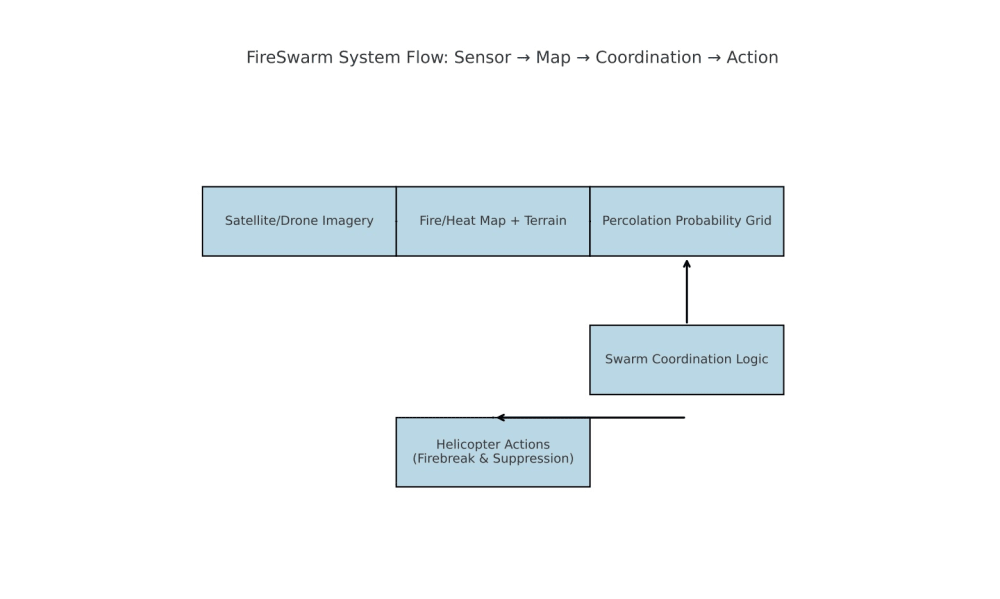FireSwarm is an integrated aerial wildfire suppression system that combines thermodynamic innovation with swarm-based robotics to control and mitigate wildfires rapidly, safely, and precisely. The system leverages a two-phase deployment strategy using semi-autonomous helicopters to execute firebreak cutting and active flame suppression using thermally disruptive ice projectiles.
The first phase uses a group of rotorcraft ("choppers") to create physical firebreaks by cutting or disrupting combustible vegetation in predetermined corridors. The second phase engages a coordinated set of "suppressor" helicopters that launch compressed-air-driven projectiles, each equipped with a metallic tip and a rear ice payload encased in a lightweight cage. On impact, the projectile bursts, releasing ice fragments that absorb substantial thermal energy through melting and vaporization. This creates a local thermodynamic shock, reducing flame temperature, increasing humidity, and momentarily disrupting airflow—contributing to firefront collapse.
What makes FireSwarm novel is not only its dual-action suppression mechanism, but its real-time decision-making engine based on percolation theory and swarm intelligence. The system transforms satellite-derived heatmaps and terrain data into a probabilistic “flammability grid” using percolation modeling, which is then updated as the fire evolves. This map enables helicopter agents to autonomously navigate and coordinate actions using rules inspired by swarm behavior: separation (to avoid overlap), cohesion (to maintain optimal coverage), and alignment (to track shifting firefront geometry).
All helicopters in the swarm evaluate local and global fire conditions to reposition dynamically, adapting to wind changes, terrain constraints, and fire spread in real-time. The system is computationally light, modular, and designed to be compatible with both human-piloted and autonomous aerial platforms.
FireSwarm can be manufactured using existing small- or mid-sized helicopters, modified with modular launch systems, onboard computation units, and remote coordination protocols. The projectile system is composed of low-cost, environmentally safe materials—ice and recyclable casings—and can be assembled and stored in remote depots or deployed on-demand. No explosive propellant is used; launching is achieved using compressed air, ensuring operational safety and mechanical simplicity.
The primary application is in large-scale wildfire events, especially in rugged or remote terrain where ground crews face extreme danger or inaccessibility. FireSwarm offers a critical advantage: fast deployment, precise suppression, and real-time adaptability, significantly reducing the risk to human personnel and increasing the likelihood of early containment.
Beyond wildfires, the system could be adapted for industrial fires, military base protection, and disaster response in climate-vulnerable zones. Its modular architecture allows scaling, integration with satellite services, and coordination with ground teams or unmanned aerial systems.
In summary, FireSwarm is a breakthrough in automated firefighting. It merges robotics, thermodynamics, and environmental modeling into a field-ready, scalable solution with high impact potential in the face of growing global wildfire crises.
Like this entry?
-
About the Entrant
- Name:Arturo Ortiz Tapia
- Type of entry:individual
- Software used for this entry:Python (for simulation and modeling) Matplotlib & NumPy (for terrain and fire spread visualization)
- Patent status:none


